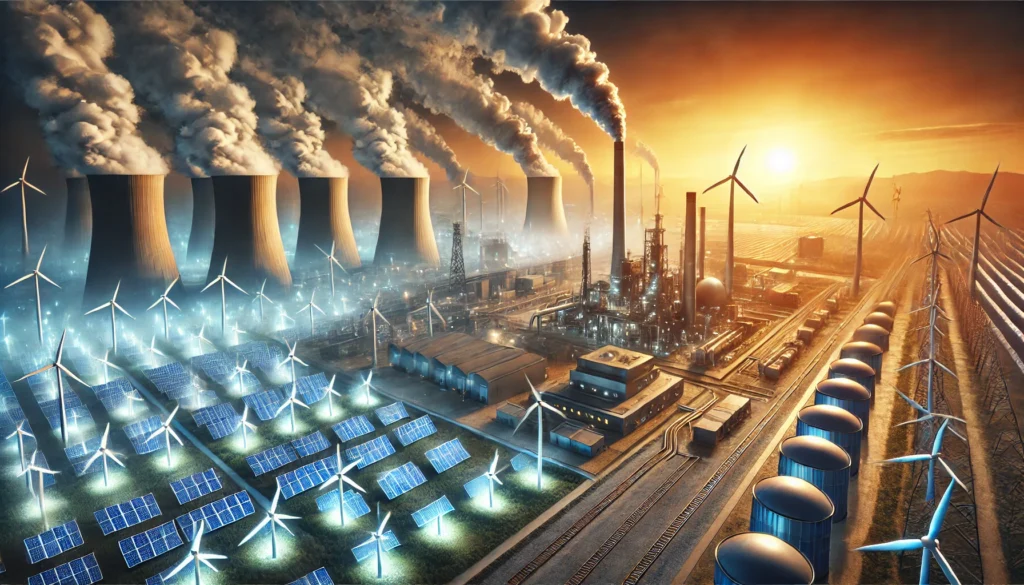For the first time in history, wind and solar energy together managed to produce more electricity than coal did for an entire year. This achievement makes history in the transition of U.S. energy. Based on the information from the United States Energy Information Agency, last year, wind and solar combined produced 669 terawatt-hours (TWh) of energy, while coal produced only 652 TWh. Nevertheless, the shift towards renewables did not lead to a decrease in carbon emissions from electricity generation, which remained approximately flat because of unprecedented amounts of natural gas used.
Renewables Ahead of Coal, but Natural Gas Grows
The rise of renewables has happened alongside an increase in the use of wind and solar and the shutting down of coal power plants. In 2024, the United States added 30 gigawatts of new solar capacity, utterly destroying the record of 19 gigawatts set in 2023. The country also added 5 gigawatts of wind power, which is the smallest annual increase since 2014 but is still dramatically above the amount of coal power.
Even though coal use went down, there was a corresponding increase in generation of electricity from natural gas, which has increased by 66 percent in the last decade. Gas-fired plants generated 738 TWh of electricity in 2014 compared to 2024, which makes natural gas the leading cause of carbon emissions in the power sector for the first time.
The Stagnation of Emissions Despite Clean Energy Growth
In previous years, reliance on renewables and gas alongside reduced coal utilization yielded an uninterrupted decline in carbon emissions from the power sector. Last year, 2024, emissions amounted to 1.54 billion tons of CO2, which was almost 29% less than what was recorded in 2014. This figure, however, was almost equal to the 2023 records of 1.52 billion tons of CO2 emissions from power plants. One significant factor at play is the growth in electricity demand. The power generation of 2024 saw a 3% rise resulting from a very hot summer along with the establishment of energy-heavy data centers. Much of this clean energy produced instead serves the new demand being built rather than displacing dirtier forms. According to a professor at Carnegie Mellon University and former Biden administration climate adviser Costa Samaras, emissions will never go down if only additional natural gas facilities are built. Sooner or later, we run out of coal to displace.
Under the Trump Administration Policy Changes
The transition to renewables will also not be without political headwinds. President Trump has promised to cut back clean energy subsidies and dismantle pollution regulations, which could further embed burning fossil fuels in the U.S. power grid. For a change, emissions reductions now appear uncertain, and how the government will be involved in facilitating the clean energy transition is being put into question.
The Future of U.S. Energy Transition
Industry experts caution that natural gas, as a source of energy, is rapidly growing compared to renewables that continue to grow. The pursuit of aggressive energy storage systems, grid modernization, and demand-side efficiency measures will prevent the U.S. from stopping the effective pace of emissions reductions.
“Considering the message from the current administration is on the increasing energy supply of which electricity forms part, that is indeed focused on promoting AI and data centers, and that is coming at a time when the number one source of new power is solar and wind,” said Robbie Orvis, modeler of energy at Energy Innovation.
Conclusion
Although it has historic importance, the overwhelming reality of coal is that the continued dominance of natural gas may inhibit emissions reductions. The next phase in the U.S. transition in energy will have to encompass larger storage, efficiency, and decarbonization investments in the gas sector so that renewables will be able to replace and not just meet the demand. Whether this internal force will be driven by policy changes, policy forces, or new technologies will be witnessed later.

